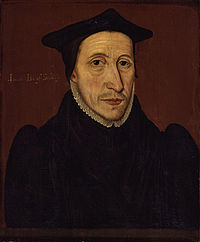
1559
A challenging sermon.
When the young king Edward VI died in 1553, England was, on paper at least, a Protestant country, with a Book of Common Prayer, services in English and married clergy. However, the new ruler, Mary I, was a Catholic who returned England to the Roman Catholic allegiance and persecuted her religious opponents, earning herself the nickname of Bloody Mary. Many Protestant clergymen fled to the Continent to save their lives and await a change on the throne. This occurred in late 1558 when Mary died, to be succeeded by her Protestant sister Elizabeth. The new queen had to replace virtually all of the high ecclesiastical office holders, dispensing with the services of those who clung to Catholicism, and restock the universities and pulpits with reliable men of her faith. No one was quite sure, however, what sort of faith that was – the Queen abolished many Catholic practices but retained a lot of ceremony and the office of bishops. Radical Protestants, later to be known as Puritans, wanted a more complete reformation such as existed in Switzerland but it seemed that Elizabeth preferred a “middle way”. On this day in 1559 England heard a sermon which would lead to the explanation of this new religious path.
It was delivered by John Jewell outside of Old St Paul’s Cathedral. Jewell had fled the Marian persecution and spent years in Protestant cities on the Continent. When he returned at the beginning of Elizabeth’s reign, he found that some of his more radical fellow exiles were out of favour with the Queen but he was given a plum post at the cathedral and later the bishopric of the rich diocese of Salisbury. In his sermon he challenged Catholic theologians to prove their claims, not out of tradition or papal decrees but out of Scripture, the first ecumenical Councils and the Fathers of the early Church. When his sermon challenge drew fire he wrote Apologia ecclesiae Anglicanae, a basic exposition and defence of the English church settlement. Queen Elizabeth ordered a copy of the Apology placed in every parish church and it became the standard statement of Anglicanism for decades.
Jewell’s work was written in Latin so that every European intellectual and theologian could read it. Many did; the Council of Trent condemned it and some leading English Catholics (themselves now in exile) wrote against Jewell. One was Thomas Harding who penned An Answer to Doctor Jewel’s Challenge (1564), to which Jewell replied (1565); then Harding published a Confutation of an Apology (1566) and was answered again by Jewell in a Defense of the Apology (1567) to which Harding replied in A Detection of Sundry Foul Errors, Lies, Slanders, Corruptions, and other False Dealings, touching Doctrine and other matters uttered and practised by M. Jewel (1568), such tit for tat debate being the accepted, if tedious, method of the day.